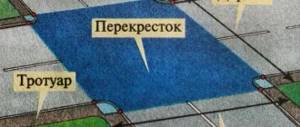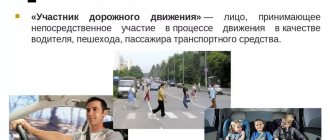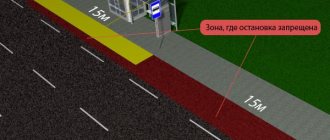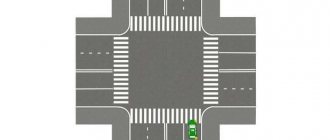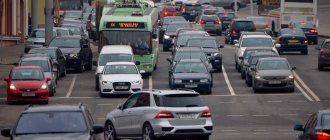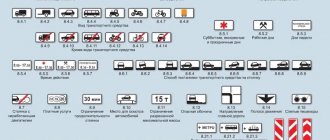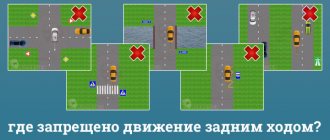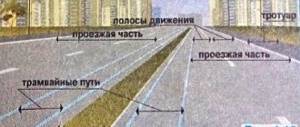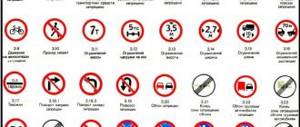Who is a pedestrian?
A pedestrian is a road user who, when moving, does not drive a vehicle or perform work on it. Pedestrians include disabled people in wheelchairs without a mechanical motor, owners of bicycles or mopeds who move them along the road.
In a word, a pedestrian is a person who walks on the roadway. According to the law, he is allowed to move on pedestrian paths, sidewalks or on the side of the road towards vehicle traffic if the first two options are not available.
Responsibilities of pedestrians
What fines are provided for running a red light
? 15. Pedestrians must move on sidewalks or pedestrian paths, and if there are none, along the sides. Pedestrians carrying bulky objects, as well as persons using non-motorized wheelchairs, may walk along the edge of the roadway if movement on sidewalks or shoulders creates an obstacle for other pedestrians.
If there are no sidewalks, pedestrian paths, shoulders, or if it is impossible to move along them, pedestrians can move along a bicycle path or along the edge of the roadway (on roads with a dividing strip - along the outer edge of the roadway) in one row.
When walking along the edge of the roadway, pedestrians must walk towards the movement of vehicles. Persons moving in wheelchairs without a motor or driving a motorcycle, moped, or bicycle, in such cases must follow the direction of travel of the vehicles.
It is prohibited to install various structures and obstacles on sidewalks, pedestrian paths and roadsides that interfere with the movement of pedestrians.
16. The movement of organized columns of pedestrians is permitted in the same direction as vehicles moving only on the right side of the roadway, no more than four people in a row.
In front and behind the column on the left side there should be escorts with red flags, and in the dark and in case of insufficient visibility - with lights on: in front - white, in back - red.
Groups of children are allowed to drive only on sidewalks and pedestrian paths, and in their absence, along roadsides, only during daylight hours and accompanied by adults.
17. Pedestrians must cross the roadway at pedestrian crossings, as well as underground and overground, and in their absence - at intersections - along sidewalks or roadsides.
If there is no crossing or intersection in the visibility zone, it is allowed to cross the road at right angles to the edge of the roadway in areas without a dividing strip and fences where it is clearly visible in both directions.
18. In places where road traffic is regulated, pedestrians must be guided by the signals of a traffic controller or a pedestrian traffic light, and in its absence, by the signals of a transport traffic light.
19. At unregulated pedestrian crossings, pedestrians may enter the roadway after assessing the distance to approaching vehicles, their speed and making sure that the crossing will be safe for them.
When crossing a roadway outside a pedestrian crossing, pedestrians must, in addition, not interfere with the movement of vehicles and exit from behind a standing vehicle or other obstacle that limits visibility without making sure that there are no approaching vehicles.
When driving along the roadway, including along a pedestrian crossing, pedestrians are prohibited from using the telephone, watching television and video products, listening to radio and audio products, reading books or periodicals, as well as using other electronic devices that distract attention. When crossing the road, pedestrians are required to walk around a stationary bus and trolleybus from behind, and a tram from the front.
When crossing the road, pedestrians are required to walk around a stationary bus and trolleybus from behind, and from a tram in front.
20. Once on the roadway, pedestrians should not linger or stop unless this is related to ensuring traffic safety. Pedestrians who do not have time to complete the crossing must stop on the line dividing traffic flows in opposite directions. You can continue the transition only after making sure that further movement is safe, and taking into account the signals of the traffic light or traffic controller.
21. When approaching vehicles with blue or blue and red flashing lights and a special sound signal on, pedestrians are required to refrain from crossing the roadway, and those on it must give way to these vehicles and immediately vacate the roadway.
22. Waiting for a route vehicle is allowed only on landing platforms raised above the roadway, and if there are none, on the sidewalk or side of the road. In stopping places for route vehicles that are not equipped with raised landing platforms, it is allowed to enter the roadway to board the vehicle only after it has stopped. After disembarking, it is necessary to clear the roadway without delay.
When moving across the roadway to or from the stopping point of a route vehicle, pedestrians must be guided by the requirements of paragraphs 18-21 of these Rules.
How to cross the road correctly?
To cross the roadway there are ground, underground and overpasses. These are the safest methods for humans. By the way, bicycle owners must cross the road on foot. But unfortunately, crossings are not available everywhere; if they are absent, a pedestrian road user can cross the roadway at an intersection along the sidewalk lines or the side of the road.
If all of the above conditions are absent, then you can cross the roadway at a right angle in an area where there are no fences or an approaching vehicle. But you need to remember about your own safety; in the dark or in poor visibility conditions, it is advisable to have reflective elements on your clothes. Despite the fact that this is a rule, there are no penalties for violation of it by law.
At a pedestrian crossing, it is also important to take care of your own safety. Before crossing the road, you need to make sure that the traffic will be safe and that there is no approaching vehicle. Because, despite the fact that the driver is obliged to let the pedestrian pass, he may not have time to brake.
Traffic regulations for pedestrian road users
The traffic rules provide for a number of points regulating the rights and obligations of pedestrians (section 4, clauses 4.1-4.16). It is on them that traffic police rely when assessing the scale of violations.
The rules provide that:
- movement is possible only on sidewalks, places for pedestrians, in special cases on bicycle paths or in one row along the side of the road or along the edge of the road;
- at night, a pedestrian who decides to go out onto the roadway must illuminate his path so that motorists can see him;
- When moving along the road, you need to pay attention to the traffic controller’s gestures and the traffic light signal.
Pedestrians are prohibited from running onto the road or pedestrian crossing themselves or allowing children to do so. Crossing is not possible if there is a dividing strip or the road has four or more lanes, as well as in places where a turnstile or prohibitory sign is installed.
Where to cross the road?
You can cross the road along zebra crossings and underground pedestrian crossings. For pedestrians, there are also safety islands on highways or lines separating traffic in different directions.
If you are already on a busy highway, then you can wait in the middle (so as not to interfere with traffic). You can cross to the other side only if the traffic light switches to green or the traffic controller gives a sign.
If there is a car in front of you, you can go around it from behind only after making sure that there are no other cars nearby. You can go around the tram to exit onto the roadway only if it has already stopped on the side of the doors.
How to cross the road correctly?
Crossing the road correctly is not difficult. It is worth adhering to the established rules and using specially provided transitions.
A pedestrian has the right:
- Count on an advantage when crossing if he does everything correctly and does not violate traffic rules.
- Make claims to utilities and other services regarding traffic safety.
If there is no crossing and the road is three-lane, then you can cross it at right angles to the edge. You can only start moving if there is no danger nearby, after first looking to the right and left. At intersections you need to move along the line of sidewalks or curbs.
Pedestrian rights
Since a pedestrian is a person who in one way or another participates in road traffic, he has his own rights defined by law. Firstly, he may be a participant in an accident, both the culprit and the victim. Here the pedestrian has the right to disagree with the charges brought against him by traffic police officers, to express his opinion and not to sign the protocol. Secondly, the legislation provides for rules for the movement of a pedestrian road user in different conditions.
But in practice, it turns out that drivers driving a source of increased danger have greater priority on the road. A pedestrian is a more vulnerable traffic participant and he is forced to take care of his safety on his own.
Fines for pedestrians
For violations of traffic rules, a pedestrian is brought to administrative responsibility. Here is the list of fines:
- When crossing the road at a red traffic light, regardless of whether there are approaching cars or not, the fine is 500 rubles.
- When crossing the roadway near a pedestrian crossing. Even if there are no barriers, excellent visibility and doing it at a right angle, you can get a fine of 500 rubles.
- According to traffic rules, you should go around the bus from behind, and the tram in front. Failure to comply will result in a fine of 500 rubles.
- If the zone into which a person has entered is marked with a “no movement” sign, he is issued a fine of 500 rubles.
- Each participant is obliged to give way to a vehicle with a beacon and special lights on. signal. If a pedestrian violates this rule, the fine for him will be 500 rubles.
- You can wait for a taxi and land on the roadway only on a specially designated lane or side of the road. For violation, a fine of 500 rubles.
- In the absence of a sidewalk or shoulder, a pedestrian can move along the edge of the roadway towards the movement of cars. In case of violation, the fine is 500 rubles.
Ignorance of the laws does not exempt citizens from responsibility, so the absence of a personal vehicle is not yet an indicator that it is not necessary to know the rules of behavior on the road.
Punishment for non-compliance with rules
The Code of Administrative Offenses provides for administrative liability for pedestrians in case of violation of rules of conduct on the road. A fine of 500 rubles or a warning is possible if traffic rules are ignored (Article 12.29 Part 1 of the Administrative Code). However, this is not the only type of fine for violators. If their actions interfered with traffic, the penalty increases to 1 thousand rubles (Article 12.30 Part 1 of the Administrative Code).
If, in addition to interference, slight or moderate damage to the health of other people occurs, the fine may increase to 1-1.5 thousand rubles (12.30 Part 2 of the Administrative Code). A monetary penalty of this size is possible only if the pedestrian’s actions lacked intent and were committed through negligence.
Only the traffic police officer who discovered the offense has the right to fine. It is impossible to fine a person who is caught on camera, since his identity cannot be identified.
Important: The traffic police inspector is obliged to draw up a protocol on an administrative offense indicating the article of the Code of Administrative Offenses and the paragraph of the traffic rules that the pedestrian violated.
In the event of an accident involving a pedestrian, the offender must provide assistance to the victims and remain on the scene until the police or traffic police arrive.
Transition to prohibition sign
We all remember the rule from childhood: you can only cross the road in a designated place. For walking on the roadway, although there is a zebra crossing or an underground crossing sign nearby, you can be fined 500 rubles. Violation of a sign prohibiting crossing is punishable in the same way. You can’t ignore the sign with a white car on a blue background, which prohibits pedestrians from driving along the edge of the road.
But crossing a red traffic light is considered the most dangerous , as there is a risk of being hit by a car or forcing the driver to hit the brakes, causing an accident. For this offense you can also be fined 500 rubles.
In the wrong place
According to the rules, pedestrians must move only on sidewalks and pedestrian paths, and stick to the right side. If there are no places for pedestrians in sight, you can enter the road for cyclists or walk along the edge of the road towards traffic so that you can see the danger. Movement should not interfere with traffic.
Such an obstacle could be, for example, a pedestrian stopping in the middle of the road to answer the phone or unexpectedly appearing on the roadway after jumping over a turnstile. Crossing the road in a prohibited place will result in a fine of 500 rubles . If you wish, you can pay only half of this money, for example, by paying off the fine in the first 20 days while the discount is valid.
How to protect yourself on the road?
Often, a pedestrian is the culprit of a traffic accident. If the damage to the car itself may be insignificant, then a pedestrian participant can say goodbye to his health or life. Therefore, despite the fact that he has his certain rights on the road, he must first take care of his safety.
First you need to learn and understand all the rules of the road. And put them into practice. In any situation, you must not let your guard down, because pedestrians suffer first, and mostly through their own fault.
If a pedestrian is a traffic participant, then he has his own rights and responsibilities along with drivers. The legislation of our country regulates all requirements and every citizen is obliged to clearly know them, first of all, in order to protect himself.

